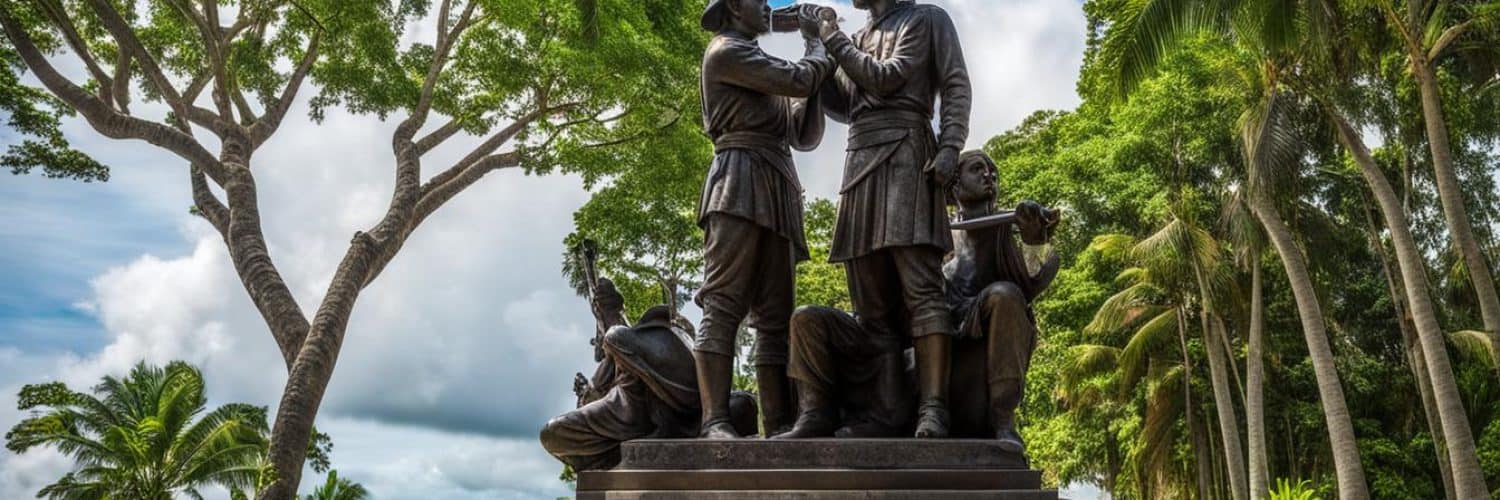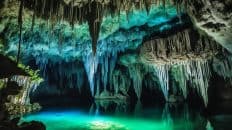Welcome to Bohol, Philippines, home to the mesmerizing Blood Compact Monument. This historical landmark is not only a prominent tourist attraction but also holds great significance in Filipino history and cultural heritage. Located in the breathtaking Visayas region, the Blood Compact Monument is a must-visit site for travelers who want to delve into Bohol’s rich history and explore its captivating tourism offerings.
Key Takeaways:
- The Blood Compact Monument is a popular tourist destination in Bohol, Philippines.
- It is a symbol of Filipino history and cultural heritage.
- The monument is located in the scenic Visayas region.
- Visiting the monument provides a deeper understanding of Filipino history and offers breathtaking views of the surroundings.
- There are numerous nearby attractions to explore while visiting the Blood Compact Monument.
The History of the Blood Compact Monument
The Blood Compact Monument in Bohol, Philippines stands as a historical landmark, commemorating the significant event known as the Sandugo or blood compact. This event took place in 1565 between Spanish explorer Miguel Lopez de Legazpi and Rajah Sikatuna of Bohol, marking the first treaty of friendship between the Spaniards and the Filipinos. The blood compact was a ceremonial ritual symbolizing the establishment of friendship, cooperation, and unity between two different races, religions, cultures, and civilizations.
The Blood Compact Monument holds immense cultural and historical significance, reflecting the rich Filipino history and heritage of the Visayas region. It serves as a tangible reminder of the enduring bond between the indigenous people of Bohol and the Spanish colonizers, showcasing the harmonious coexistence and mutual respect between different communities. The monument stands not only as a testament to the past but also as a source of inspiration for fostering unity and friendship in the present and future.
The Design and Symbolism of the Monument
The centerpiece of the Blood Compact Monument is a sculpture created by National Artist Napoleon Abueva, a renowned Filipino sculptor. The sculpture depicts five life-sized figures gathered around a table, with Miguel Lopez de Legazpi and Rajah Sikatuna at the center, raising their glasses in a toast. It is made of alabaster stone or cement, cast in bronze, and welded metal. The attention to detail and artistry in Abueva’s work adds a sense of grandeur to the monument. The sculpture symbolizes unity, friendship, and the historical significance of the blood compact event.
The sculpture is a masterful representation of the historical event, capturing the essence of the blood compact that took place in 1565 between Spanish explorer Miguel Lopez de Legazpi and Rajah Sikatuna. Abueva’s choice of materials, such as alabaster stone or cement, cast in bronze, and welded metal, enhances the visual impact of the monument.
“The sculpture symbolizes unity, friendship, and the historical significance of the blood compact event.”
The life-sized figures around the table reflect the coming together of different cultures, represented by Miguel Lopez de Legazpi and Rajah Sikatuna. The raised glasses in a toast symbolize the ceremonial ritual that established friendship and cooperation between the Spaniards and the Filipinos. It serves as a reminder of the first treaty of friendship between two different races, religions, cultures, and civilizations.
Abueva’s meticulous attention to detail is evident in every aspect of the sculpture, from the facial expressions of the figures to the intricate textures and folds of their clothing. The composition of the sculpture draws viewers’ eyes to the central figures, emphasizing the significance of their encounter.
Sculpture Symbolism:
| Symbol | Meaning |
|---|---|
| Life-sized figures | Representation of historical figures and their significance |
| Raised Glasses | Symbolic toast and establishment of friendship |
| Different materials | Visual impact and durability of the sculpture |
| Attention to detail | Enhances the overall grandeur of the monument |
The symbolism embedded within Abueva’s masterpiece adds depth to the historical narrative represented by the Blood Compact Monument. The sculpture serves as a powerful reminder of the unity and friendship between different cultures and the historical significance of the blood compact event in Filipino history.
Location and Surroundings
Located in Barangay Bool, Tagbilaran City, Bohol, the Blood Compact Monument offers visitors a picturesque setting amidst a scenic landscape. Perched on an open and raised dais, the monument provides breathtaking views of the idyllic Bohol Sea and the surrounding natural beauty of the island.
Tagbilaran City, known as the gateway to Bohol, serves as the perfect backdrop for the Blood Compact Monument. Situated in the heart of the city, the monument stands as a symbol of cultural and historical significance, blending seamlessly into its vibrant surroundings.
“The Blood Compact Monument is a testament to the beauty of Bohol’s scenic landscape and the historical legacy it holds.”
As visitors explore the monument, they can take in the panoramic views and appreciate the tranquil atmosphere. The sight of the Bohol Sea stretching out before them serves as a constant reminder of the unbreakable bond forged during the blood compact event.
Whether bathed in the warm glow of the setting sun or basking in the gentle breeze of a clear day, the surroundings of the Blood Compact Monument create an immersive and memorable experience for all who visit.
Tourism and Visitor Experience
The Blood Compact Monument is not only a significant historical landmark but also a renowned tourist attraction in Bohol, Philippines. Its cultural and historical significance makes it a must-visit site for travelers exploring Bohol’s rich tourism offerings.
Visitors to the Blood Compact Monument have the opportunity to explore the monument itself and learn about the history and cultural importance of the blood compact event. The monument provides a glimpse into the past, showcasing the friendship and cooperation between Spanish explorer Miguel Lopez de Legazpi and Rajah Sikatuna of Bohol. This significant event holds a special place in Filipino history and is an integral part of the cultural heritage of the region.
Located in an easily accessible area, the Blood Compact Monument is often included in tourism itineraries for those visiting Bohol. Whether traveling solo, with family, or in a group, tourists can enjoy the scenic views and appreciate the artwork displayed at the monument. The picturesque surroundings, including the breathtaking view of the Bohol Sea, add to the overall visitor experience.
As a traveler, immersing yourself in the history and heritage of a destination is an essential part of the journey. When visiting the Blood Compact Monument, you not only get to witness the beauty of the site but also gain a deeper understanding of Filipino history and heritage.
To enhance your experience at the Blood Compact Monument, consider spending some time exploring the nearby attractions such as the St Joseph the Worker Cathedral, National Museum, Baclayon Church & Watchtower, Philippine Tarsier Sanctuary, Alona Beach, and Danao Beach. These attractions offer a diverse range of experiences, further enriching your visit to Bohol.
| Visitors’ Experiences | Highlights |
|---|---|
| Appreciating the historical significance | Understand the blood compact event and its impact on Filipino history |
| Scenic views | Enjoy the picturesque surroundings of the monument and the Bohol Sea |
| Cultural immersion | Learn about the cultural heritage of the Visayas region and the Philippines |
| Accessibility | Easily accessible and often included in tourism itineraries |
| Opportunity for reflection | Contemplate the historical event and its significance in a peaceful setting |
Nearby Attractions in Bohol
When visiting the Blood Compact Monument in Bohol, visitors have the opportunity to explore other nearby attractions. These include the St Joseph the Worker Cathedral, the National Museum, the Baclayon Church & Watchtower, the Philippine Tarsier Sanctuary, and the picturesque beaches of Alona Beach and Danao Beach.
St Joseph the Worker Cathedral
The St Joseph the Worker Cathedral is an elegant church with a rich history. Its majestic architecture and beautiful interiors make it a significant religious and cultural landmark in Bohol.
National Museum
The National Museum in Bohol houses a collection of anthropologically interesting items. Visitors can explore exhibits that showcase the unique cultural heritage and history of the region.
Baclayon Church & Watchtower
The Baclayon Church & Watchtower is a testament to Bohol’s architectural heritage. This well-preserved church and watchtower complex is a must-visit for history enthusiasts.
Philippine Tarsier Sanctuary
The Philippine Tarsier Sanctuary is a conservation area where visitors can see saucer-eyed tarsiers in their natural habitat. It offers a unique opportunity to observe these adorable and endangered creatures up close.
Alona Beach and Danao Beach
Bohol is known for its stunning beaches, and Alona Beach and Danao Beach are no exception. With their pristine white sands, crystal-clear waters, and vibrant marine life, these beaches are perfect for relaxation and water activities.
Nearby Attractions Comparison
| Attraction | Description |
|---|---|
| St Joseph the Worker Cathedral | An elegant church with rich history and majestic architecture. |
| National Museum | Houses anthropologically interesting items and showcases regional cultural heritage. |
| Baclayon Church & Watchtower | A well-preserved historical complex highlighting Bohol’s architectural heritage. |
| Philippine Tarsier Sanctuary | A conservation area where visitors can observe saucer-eyed tarsiers in their natural habitat. |
| Alona Beach | A picturesque beach known for its white sands, clear waters, and vibrant marine life. |
| Danao Beach | A scenic beach offering relaxation and various water activities. |
Art Critique of the Sandugo Sculpture
The Sandugo sculpture at the Blood Compact Monument has captivated art critics with its impeccable craftsmanship and profound significance. Created by the esteemed Filipino sculptor Napoleon Abueva, this masterpiece has garnered praise for its massive dimensions and enduring nature. The sculpture’s bronze color, combined with its strategic placement on an elevated pedestal, contributes to its timeless appeal.
“The Sandugo sculpture is a magnificent representation of historical events and emotions. Abueva’s artistry shines through in every intricate detail, capturing the essence of the blood compact ceremony. It serves not only as a remarkable work of art but also as a sacred space for reflection, honoring the profound historical event it symbolizes.” – Art Critic
The Sandugo sculpture offers more than just an aesthetically pleasing sight; it serves as a powerful embodiment of remembrance, allowing individuals to contemplate the historical significance of the blood compact event. With every visit to the Blood Compact Monument, visitors are reminded of the unity, friendship, and cultural heritage showcased by this remarkable sculpture.
The Sculptor: Napoleon Abueva
Napoleon Abueva, a Filipino sculptor, is widely recognized as the “Father of Modern Philippine Sculpture.” Born in Tagbilaran, Bohol, Abueva’s artistic brilliance and dedication to preserving Philippine heritage are evident in his works. In 1976, he was honored with the title of National Artist of the Philippines for Visual Arts, a testament to his contribution to the country’s cultural landscape.
Abueva’s artistic journey began at the University of the Philippines, where he pursued a Bachelor of Fine Arts in Sculpture. His versatility as an artist is unmatched, as he effortlessly transitions between working with various materials. From alabaster stone to bronze and welded metal, Abueva skillfully brings his artistic vision to life.
What sets Abueva apart is his ability to blend academic representational style with modern abstract techniques. This unique fusion creates sculptures that are both visually captivating and intellectually thought-provoking. Abueva’s works transcend traditional boundaries, leaving a lasting impression on viewers.
One of his renowned creations is the centerpiece sculpture at the Blood Compact Monument, part of the historic Blood Compact Heritage Site in Bohol. The sculpture depicts five life-sized figures, showcasing Abueva’s attention to detail and his ability to capture the essence of the blood compact event. Through his artistry, Abueva immortalizes the significant moment in Filipino history, symbolizing unity and friendship between different cultures.
Conclusion
The Blood Compact Monument in Bohol, Philippines is a historical landmark and tourist attraction that is a testament to the rich cultural heritage and Filipino history. Situated in the beautiful Visayas region, this monument is a must-visit travel destination for those who want to delve into the captivating past of the country.
With its striking design and symbolic significance, the Blood Compact Monument stands as a powerful representation of unity and friendship between different races and cultures. The sculpture, created by the talented Filipino sculptor Napoleon Abueva, adds a touch of artistry and grandeur to the monument, offering visitors a glimpse into the country’s vibrant artistic tradition.
Located in Barangay Bool, Tagbilaran City, the Blood Compact Monument provides both a historical and visual treat. The monument is not only a site to appreciate and learn about Filipino history, but it also offers breathtaking views of the scenic landscape and the Bohol Sea. It is indeed a perfect destination for travelers seeking a combination of cultural exploration and natural beauty.
For those planning a visit to Bohol, the Blood Compact Monument is just one of the many attractions in the area. From stunning churches and museums to unique wildlife sanctuaries and picturesque beaches, Bohol offers a range of experiences that will captivate any traveler. Exploring these attractions not only offers a fun-filled adventure but also provides a deeper understanding of the rich heritage that the Philippines has to offer.
FAQ
What is the significance of the Blood Compact Monument in Bohol, Philippines?
The Blood Compact Monument holds great significance in Filipino history as a symbol of cultural heritage. It commemorates the Sandugo or blood compact event, which was a ceremonial ritual to establish friendship and cooperation between the Spaniards and the Filipinos in 1565.
Who created the sculpture at the Blood Compact Monument?
The centerpiece sculpture at the Blood Compact Monument was created by National Artist Napoleon Abueva, a renowned Filipino sculptor.
Where is the Blood Compact Monument located?
The Blood Compact Monument is located in Barangay Bool, Tagbilaran City, Bohol, Philippines.
What can visitors expect when visiting the Blood Compact Monument?
Visitors can explore the monument, learn about the history and cultural significance of the blood compact event, and enjoy the scenic views of the island and the Bohol Sea.
What other attractions are nearby the Blood Compact Monument?
Nearby attractions include the St Joseph the Worker Cathedral, National Museum, Baclayon Church & Watchtower, Philippine Tarsier Sanctuary, and the picturesque beaches of Alona Beach and Danao Beach.
Who is the sculptor Napoleon Abueva?
Napoleon Abueva is a Filipino sculptor and National Artist of the Philippines for Visual Arts. He is known for his versatility in working with various materials and blending academic representational style with modern abstract techniques.


















Add comment